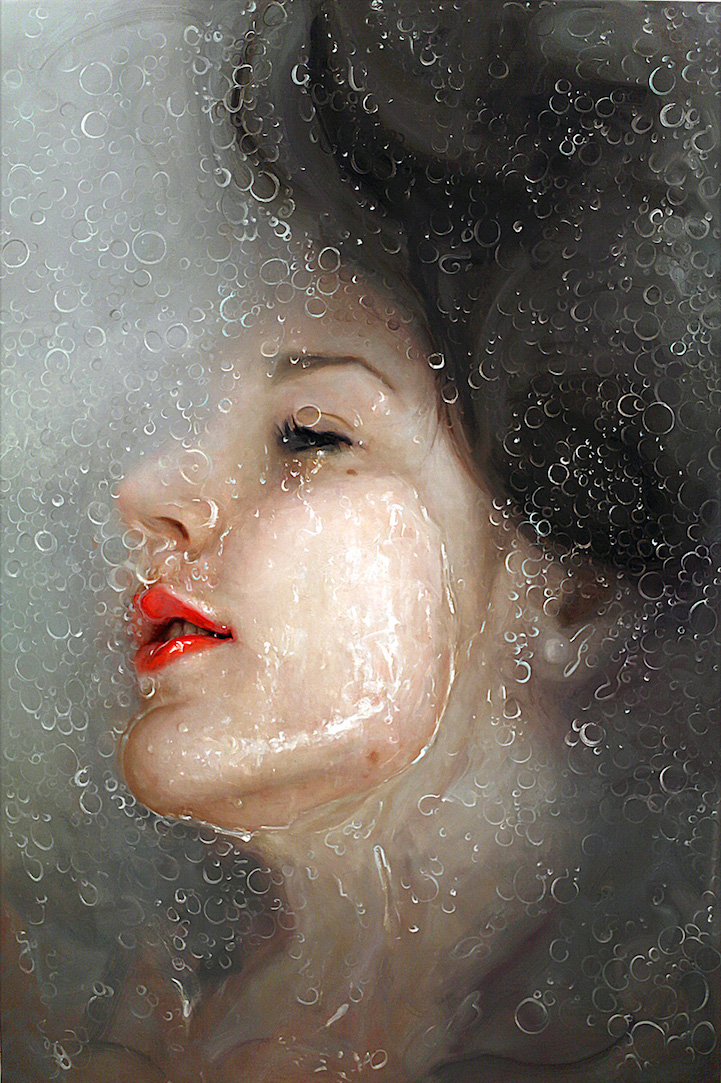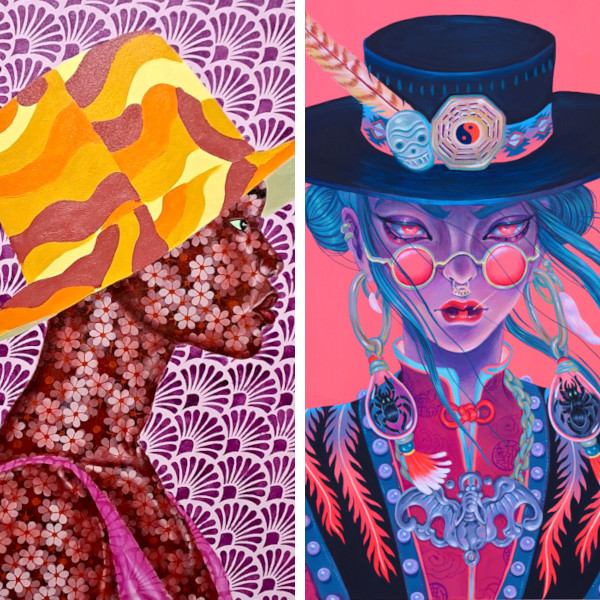Brooklyn, New York-based painter Alyssa Monks captures the complex, multifaceted experience of being human in her intimate portraits of people half-hidden beneath layered surfaces. Bordering on hyperrealistic and surreality, while simultaneously venturing into the abstract, her oil paintings are masterful displays of both technical skill and artistic expression. The face of each of her subjects, whether concealed behind steamy panels of glass, swirling and frothing bathwater, or earthy depictions of trees, portrays a certain vulnerability that elevates the artwork into a haunting display of emotion.
“My intention is to transfer the intimacy and vulnerability of my human experience into a painted surface. I like mine to be as intimate as possible, each brush stroke like a fossil, recording every gesture and decision,” Monks writes on her website.
We were lucky enough to ask the artist a few questions about her work and inspiration. Scroll down to read that exclusive interview, and keep an eye out for Monks' upcoming solo show at Forum Gallery in NYC from March 24 to May 7, 2016.


Did you always know that you wanted to be an artist?
I started painting with oils at about 8 years old, maybe younger, I don't remember. I have a memory of taking an oil painting class while I was kindergarten, too. But by the time I was about 14, I was pretty sure this was my path. I can't say I had it all thought out, and most adults were trying to steer me into a more practical, life-sustaining career. But, I was already forming much of my identity and devoting my time and focus on painting. By 17, I was totally committed and fighting for it. When it came to figuring out money, I thought I'd be an assistant or waitress for my income, as long as I could paint. That was the plan.

How did you come to develop your own style and voice as an artist?
I'm still doing that. That never ends. It's about your life experience and how that affects your vision, perspective, priorities, attention, motivation–all that goes into the work. My one requirement of myself is that I stay true to what is real and important for me. I paint from my own set of aesthetics and attractions. I paint what resonates with me emotionally. I didn't always do that directly, but now I'm a bit more sure that if you reveal your own vulnerability and humility, there is great power in connecting to others. This works in relationships, and it works in art.
The style is a result of using my own personal aesthetics as a compass, as opposed to what will please or is already pleasing others. The voice is a result of telling the truth about what I feel and see and desire.

Who or what are some of your major sources of inspiration?
My mother, her life, and her passing have been a great source of influence on my work. She lived in a very creative way, and she brought her own creative attitude and experimental technique to everything she did. Being so close to her was a constant lesson on how to live creatively, how to be willing to try new things, how to be willing for them to not always work out and enjoy it anyway. She knew how to enjoy life and love whatever she was doing.
This is very important for an artist; we have to love what we do, even when it isn't delivering the satisfaction we'd hoped. We have to keep finding ways to get inspired, excited, curious, challenged. Artists who do this always inspire me. It's never about the artist, but a specific piece or even moment in a piece that shows daring unpredictability that makes me excited. I love art that I can't quite walk by easily, not sure if I like it or not immediately, and am drawn to look as closely as possible to try and decode the material, the energy behind it, the process, the choices. This can happen in music and film, as well as in painting and photography. It can happen in cooking, dancing, conversation, and most things that allow space for new thoughts.


In many of your paintings, the subjects' faces are partially or entirely obscured–by water, steam, translucent layers of foliage, etc. What's the reason behind this shrouding?
It is partly compositional, which for me isn't consciously metaphoric or symbolic, really, but more intuitively driven. After completing so many paintings in which the water, steam, glass, or vinyl are obfuscating the person in the painting, I suppose I could say that there is a deep meaning about how we don't really see the whole person in front of us; we see bits and pieces and put together our own version or understanding of who is there. But I was drawn to these “filters” that destroy and abstract the image because they complicate the surface, make it interesting, draw me in, and challenge my mind and eyes.

Are there other motifs or themes that you find yourself returning to time and time again in your work?
Filters, layering imagery, complicating the image to be something you have to think twice about to really understand.


Among other things, you balance painting with teaching, lecturing, and hosting workshops. How does your role as an educator fit alongside your role as an artist?
I really believe that art making is a conversation and we'll all enjoy it a lot more and expand our knowledge and inspiration if we work together in some way. Teaching and working with students in different ways is a collaborative process for me. It allows me to rekindle my curiosity and excitement and get back to a “beginner's mind” moment. It isn't something I planned on, but it has been a very enriching and valuable part of my life and practice.


What are some new projects or paintings that you're excited to work on in the near future?
I'm working on a new series of “Earth” paintings, in which I'm now using leaves, branches, sky, and earth as the filter through which to find the person within. It's a different feeling than the shower and water pieces. More connected to others, and a bit more vulnerable. I hope it creates comfort and a feeling of connection for those who consume the work.


 Photo credit: Stephen Churchill Downes / Courtesy Alyssa Monks
Photo credit: Stephen Churchill Downes / Courtesy Alyssa Monks
Alyssa Monks: Website | Facebook | Instagram | Twitter
My Modern Met granted permission to use images by Alyssa Monks.























































































